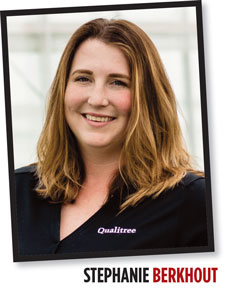9/1/2022
Life in the Fast Lane
Stephanie Saccomano

Let’s face it: being a grower can often feel like we’re “no-lifing” in the midst of the growing season. Everything is happening all at once, pest pressures can be mounting, the crop can always be better and the to-do list seemingly grows faster than your plants do.
“We’ll get to that when things slow down” becomes a joke that you chuckle at in the thick of things with your team. As more things are relegated to that eventual, mystical “slower time,” you realize that it being slow won’t actually be the case. But the thing is, no-lifing leads to burnout and burnout leads to mistakes and poor health. So what can we do to help make the workload a little easier and more enjoyable? Let’s consider the ways …
Collaborate and cross-train. It’s not just for the gym! In situations where you have multiple section growers or assistants, building bench strength by training people in growing different crops and locations is short-term pain for long-term gain. In the middle of the season we’d toss up the roster and swap people out of their growing sections or other roles entirely. It was stressful at times, but it ultimately led to better understanding, trust and coverage options. Collaborating becomes easier. It’s also incredibly helpful to understand the “customers” within your own team, such as a propagation grower seeing how their crop performs as a finishing product.
Outside of the direct management of growing spaces, other technical skills were identified on the team. We highlighted our weak points: responsibilities that one/few people knew how to carry out and worked on rectifying. We’ve built up enough that even a grower can take a holiday outside of wintertime (gasp!). We’re still building on additional people so we can be even more flexible with vacation and weekend coverage—a quest to remove the “no” from “no life.”
What helps with all of this is being on the same page … literally. We consistently work on pulling the experience from what’s up in the brain down into documents for future reference.
Contributing to crop culture for the whole team helps us easily access data for decision making, mutual understanding, training and troubleshooting purposes. What worked in the past? What didn’t? Creating standard operating procedures that are readily accessible makes everyone’s life easier when training or covering. Reviewing as a team opens the floor for discussion, changes and buy-in. Additionally, including different trial results (products, growing techniques, environments, etc.) in crop culture helps prevent double work in the future. Undocumented tests can ultimately be a waste of time.
Simplify, improve and automate the day-to-day. Automating and systematizing processes can help a grower square away some of the simple chores and focus on the bigger picture. We’ve been working on steering away from manual irrigation valves and moving toward having all irrigation cycles triggered based on weight. Our growers are still in the driver’s seat for making a decision on what thresholds their crops should tolerate—having the scales in place just helps remove guesswork.
Additionally, qualitative descriptors of “dry” and “wet” are now given a numerical value that can be checked when accessing the control program (we use Argus). It’s definitely a work in progress, but the peace of mind it can bring is priceless. Remote access to Argus is also a huge help, being able to log in from our mobile devices while in the field or from home.
Further to that, we’ve updated our alarm dialer to a unit with more outputs. This means we could now tailor specific Argus alarms to different section growers for daytime hours and easily rotate through a schedule for overnight emergencies.
Another big win for us over the last year or so has been building a better understanding of how Argus works—learning how to construct logic to program new equipment the way we need to, as well as making improvements to control equations that’d been pre-installed for us. We’ve also been able to build custom screens within the program that make navigating different growing spaces simpler or more graphical. This means less time and mental real estate in the computer and more time in the crop considering plant needs.
Despite the above improvements, one thing we cannot easily program or delegate away is the little voice in our head that rattles on even after our shoes are kicked off for the day. The weather changes—we think about what the implications are for our crop. The phone rings—is it a critical alarm? We take GrowerTalks home to read after dinner and consider what could be applied. It’s a reflection of passion and care for the job and is a double-edged sword.
We can’t shut this off all the time, but we can implement change to make things easier and cut out time-consuming or stressful tasks as much as possible. If we keep things fun, we no-life because we want to, not because we have to. That’s a sweet spot to reside in. GT
Stephanie Saccomano is Indoor Spaces Lead Grower for Qualitree Propagators in Rosedale, British Columbia, Canada.